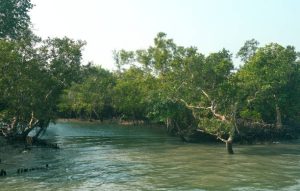
Sundarbans – An Everlasting 200-Year-Old Mangrove Sanctuary
Introduction
Home to the majestic Royal Bengal Tiger, the Sundarbans Tiger Reserve is a haven for nature and also for wildlife lovers. In fact, serving as a gateway to the mangrove forest to explore the region’s rich and diverse wildlife, it offers an unforgettable experience, making it a must-visit destination for every tourist.

Sundarbans and Mangrove forests are a beautiful demonstration of the power and majesty of nature. The scenic 200-year-old mangrove forest ecosystem with a UNESCO World Heritage Site, also remains an interesting and fascinating destination. As a result, the mangrove forest possesses unmatched levels of diversity, and it is a habitat for millions of individual species and a valuable natural wonder of the world.
In fact, the Sundarbans and Mangrove forests protect coastlines from heavy storms.
Also, the sounds of wildlife surround you, and the peaceful mangrove forest gives a break from busy modern life. In turn, this living tapestry continues to fascinate and bewilder, with the lasting force and enchantment of nature that rules supreme.
The Ancient Origins of the Sundarbans
A Glimpse of the Geologic Past
Sundarbans did not occur overnight. It took centuries to develop. In fact, over many centuries, geological forces worked against each other. They built the vast Sundarbans and Mangrove delta we see today.

The formation of a Delta in the Sundarbans
It is where all these giant rivers, the Ganges, Brahmaputra, and Meghna, converge. Besides that, they bring with them vast quantities of sand and mud. These sediments, over thousands of years, formed new land. It was a slow process by which the first mangrove forests formed.
Adjustment to Time: Mangrove Evolution
Mangrove trees possess special adaptations to survive in brackish water. Similarly, all the rest of the mangroves grow pneumatophores or aerial roots. Other trees grow prop roots to support them in soft mud. These amazing trees have survived for centuries.
The Living Tapestry: Biodiversity of the Sundarbans
Homeland of the Royal Bengal Tiger and More of the Sundarbans
The Sundarbans are renowned for their rich and diverse wildlife, with the Royal Bengal Tiger reigning as its undisputed king. Along with the tiger, many other remarkable species inhabit this vast mangrove forest. In fact, from land to water, the forest teems with an extraordinary variety of life, making it one of the most vibrant ecosystems in the world.
The Apex Predator: Royal Bengal Tiger
The Sundarbans tiger has some special abilities. As a result, they are saltwater channel expert swimmers. In addition, they are expert predators who become successful in wet weather. Hence, there are nearly 100 Royal Bengal Tigers that live in the mangrove forest.
A Symphony of Species
There are some other animals that live in this special niche. Just like, clearly spotted Deer feed peacefully in the shade of trees. Likewise, estuarine crocodiles hide on the muddy shores. Moreover, you are most likely to spot river dolphins playing in the wider waters. There are plenty of species of birds, kingfishers and egrets among them, which fly by. Moreover, animals depend on one another to survive.
The Submarine World
Beneath the surface lies an entirely different world, teeming with life. Particularly, several species of fish thrive in the brackish waters, each adapted to the unique mix of salt and freshwater. These fish are not a vital source of food for the local communities. Furthermore, they play a crucial role in maintaining the balance of the entire ecosystem’s food web. Hence, from feeding larger predators to supporting the livelihoods of fishermen, their presence is essential to the health and sustainability of the Sundarbans.
Living in Sundarbans: A Journey Through Time

Crossing the Waterways
Boats are the only mode of transport in the Sundarbans. Moreover, this mode of transport gives you a really rare view. You get to see the forest from the middle.
Boat Safaris: The Perfect Overlook
Boat travel is an excellent experience. Along with small wooden boats or bigger boats, take you deep within. You can also hear the soothing sounds of the woods that surround you. Moreover, you keep an eye out for animals on the beaches. The cool air sweeps across your body.
Travelling Down the Creeks and Rivers
However, the Sundarbans is a riverine system made up of an intricate system of rivers. Numerous tidal creeks and canals flow within the forest. In fact, they are the backbone of the well-being of the ecosystem. They also enable you to access the inner parts of the forest segments.
Surrendering to the Natural Beauty
The Sundarbans has vistas that actually hypnotise you. Even so, its natural beauty is a genuine heaven. Every and all vistas are an eye treat. The atmosphere is also teeming with life in the form of nature.
The Legendary Sundari Tree and Mangrove Forests
The Sundari tree (Heritier fomes) is the most impressive of the mangroves. It is also the most prominent member of this forest. Moreover, the green, dense canopy of the mangroves makes it a near-magical location. To step into this location is to enter a dream.
Sunrise, Sunset, and the Tidal Dance
The sunrises and sunsets here are truly enchanting, painting the sky with vibrant shades over the shimmering sea. The tides play an equally important role in shaping the landscape.
Conservation and the Future of this Ancient Ecosystem
Maintaining a Lasting Heritage of Sundarbans
Protecting the Sundarbans is a great job. In fact, we have to be extra careful about this location at all times. It’s destiny is in our hands.
Combating Threats: Human Activity and Global Warming
Climate change is a big problem here. Sea level rise can flood the land. The crop is also spoiled by the salt content in the water. Human beings are cutting down trees. The ecosystem is highly sensitive.
Community-Based Conservation Programs
Locals participate in certain conservation efforts for the Sundarbans. Locals defend their home by mobilising. Ecotourism also helps the economy and conservation. As a result, both these causes can be contributed to by tourists directly.
Sustainable Tourism: Your Role in Conservation
Your trip to Sundarbans can be a contribution towards its conservation. Moreover, Ecotourism makes a significant contribution. Every tourist makes a contribution to their future. Make your trip a positive contribution to the forest.
Responsible Travel Tips for Sundarbans Travellers
Choose eco-friendly tour groups. Try to generate as little waste as you can. In fact, always be careful of the wild animals that you will meet. Support the locals who live and work in the Sundarbans.
Assist with Conservation Projects
You can assist in the conservation of this valuable location. Moreover, try donating to organisations that assist in the conservation of the Sundarbans. Some tours also allow you to assist with scientific projects. Whatever assistance you can provide is beneficial.

Top 10 places you need to visit in Sundarbans
1. Sajnekhali Wildlife Sanctuary of Sundarbans
The perfect introduction to Sundarbans, Sajnekhali is renowned for its avifauna. Watch for kingfishers, pelicans, and plovers, and also visit the Mangrove Interpretation Centre to understand the special ecosystem.
2. Sudhanyakhali Watch Tower of Sundarbans
This is one of the best tiger spots, and also this watchtower is ringed by a sweet water pond where tigers, deer, and crocodiles come to drink.
3. Dobanki Watch Tower of Sundarbans
Renowned for its thrilling canopy walk that towers above the mangroves, Dobanki offers sweeping views of the forest’s beauty. Moreover, a fantastic spot to witness wildlife up close, including graceful spotted deer and soaring Brahminy kites.
4. Netidhopani Watch Tower of Sundarbans
This watchtower is where history and nature come together, in addition to featuring the 400-year-old ruins of a Shiva temple alongside a serene natural lake. The best place for tiger glimpses.
5. Kalash Island of Sundarbans
Famous for its peaceful beaches and also being a nesting ground of the Olive Ridley Turtle, Kalash is best suited for peaceful nature walks and bird watching.
6. Halliday Island of Sundarbans
With the rare barking deer, Halliday Island wildlife sanctuary also provides a serene sanctuary for viewing unusual wildlife in stunning scenery.
7. Bhagatpur Crocodile Sanctuary of Mangrove forest
This breeding facility is committed to the conservation of estuarine crocodiles, also offering tourists the opportunity to observe the giants nearby in a safe environment.
8. Bonnie Camp of the Mangrove forest
Locally known as Bonycamp, this solitary watchtower stands in the heart of the jungle, offering a perfect wilderness retreat. Moreover, breathtaking views of the mangroves and an eerie stillness—only broken by the distant calls of wildlife—promise a truly unique and memorable experience for visitors.
9. Sundarbans Tiger Reserve
Home to the majestic Royal Bengal Tiger, the Sundarbans Tiger Reserve is a haven for nature and wildlife lovers. In fact, serving as a gateway to explore the region’s rich and diverse wildlife, it offers an unforgettable experience, making it a must-visit destination for every tourist.
10. Mangrove Forests
Finally, just to travel along Sundarbans’ winding waterways is to discover the loveliness and intricately designed layout of the largest mangrove forest in the world, where exotic plant and animal life abounds.
Conclusion
In conclusion, the Sundarbans is really one of a kind. It is also a living, historic mangrove sanctuary. Its value to the world cannot be measured. This timeless forest is an experience like no other.
In fact, Tourists can witness stunning biodiversity. Moreover, you will be able to witness strong tigers and other types of birds. Serpentine waterways also provide thrilling excursions into the wilderness.
As a result, make your visit a step towards its preservation. Visit this great site with caution. Your visit preserves this precious natural heritage. This old ecosystem is worthy of our utmost respect.



